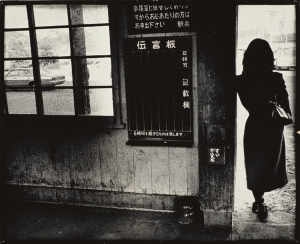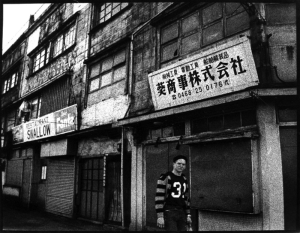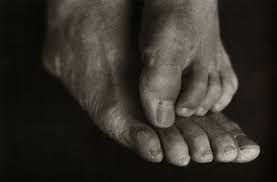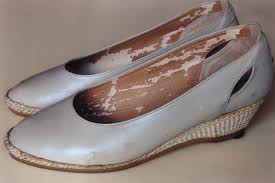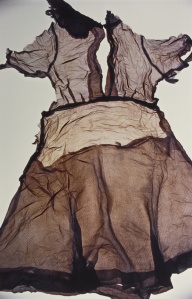The Getty Museum – 20th February 2016
This exhibition was a major retrospective of the work of the Japanese Photographer Ishiuchi Miyako. Ishiuchi was born Fujikura Yōko in 1947 and grew up in Yokosuka a Japanese city where the USA established a major naval base in 1945. She studied art in Tokyo in the late 1960s but dropped out of the course. She took up photography in 1975 and started exhibiting under her mother’s maiden name, Ishiuchi Ishiuchi, the same year.
Looking through the groups of work in this exhibition it was really clear that Ishiuchi’s work is really dominated by the aftermath of the second world war and its impact on Japan. Throughout her career she has worked developing themed sets of work many of which hark back to the war and its impact of people and places.
The first body of work in the exhibition was “Yokosuka Story” which formed the basis of her fist show in 1977. This work captures the city of Yokosuka where she grew up and presents it as a dark and somewhat dangerous place. In part this sense of hidden danger is due to the large US Naval base in the town and the resulting clash of cultures that must have occurred through the 1950s, 60s and 70s as Japan changed from being defeated nation to a major industrial power. Typical of the work in this section is the work below which shows the back of a US sailor either pulling a drunken comrade or perhaps a prostitute across a road
Other works in this section had a more hidden sense of danger or fear for example the picture below of the little girl apparently rushing away in what looks like a very forbidding neighborhood.
In another image there is a woman standing in a doorway with a large American car visible through the window on her left which I am sure we are expected to perceive as a prostitute waiting for clients.
This set of work has looks like it was taken on fast black and white film to create a very grainy effect that adds to the foreboding quality of the scenes being recorded.
The second group of work in the exhibition was entitled Yokosuka Again, this work features areas of Yokosuka in the central neighborhood near the US base. This was an area where Ishiuchi was forbidden to go as a child and one she found hard to photograph. The impact of the dual cultures is much more obvious in images like that below than the earlier set.
Ishiuchi’s third set of work was called “Apartment” and consisted of images of the cheap poorly built and cramped apartments that most people lived in in post war japan. I found looking at these images quite depressing, in their own way they are perhaps more of an indictment of the impact of war then any battlefield scenes. The picture below is perhaps typical of this body of work although much of the work also focused on derelict apartments perhaps offering some slight sense of hope for the future as these cheap, cramped apartment blocks were replaced.
In the 1980s Ishiuchi created a body of work entitled 1.9.4.7 in which she photographed the bodies of women born in the same year as her (1947). In this work she eliminated any facial portraits to enhance the anonymity of her sitters and focused on close up views that focus wrinkles, calluses and other imperfections that appear on the body over time.
After her mother died in 2000 Ishiuchi started on a body of work call “Mother’s” where she photographed her mother’s clothing and belongings. In some cases, she taped her mother’s clothes to a glass door and in others she took closes up of shoes lipsticks and other personnel effects.
The examples above capture the style of this body of work in which the back lit images of clothing contrast with the colour close-ups. After she first exhibited this work realised that these images resonated with many visitors taking them from being a private expression of grief into a powerful universal eulogy.
The final work in the exhibition was entitled “Hiroshima” in which she photographed objects that had been devastated by the US atomic bombing of the city. Mages in this series feature objects once owned by women that had been in contact with their bodies at the time of the bombing. Although the subject matter and underlying message is quite different Ishiuchi used a similar to that in her body of work mother’s. Again there are close-ups of watches and other objects although in this case these are all damaged to some degree. There are also back lit images of clothing
It was interesting to see such a large retrospective of a photographer whose work I had not previously seen from a culture of which I had a very limited understanding of. I have always like the look of grainy black and white film from the 70s and 80s and I really thought that this added a lot of atmosphere to Ishiuchi Yokosuka and apartments work and helping communicate a sense of foreboding and fear in the scenes depicted. The work has a very gritty documentary feel about it presenting a very dark view of post-war Japan. In some ways this is surprising given that by the late 1970s the post-war economic boom in Japan was in full swing. Although perhaps this really is not documentary work but a reflection of Ishiuchi’s feelings from her childhood.
Ishiuchi’s later work “mother’s” and “Hiroshima” work on much more obvious emotional level but still invoke a strong vision of history that is also evident but more hidden in her earlier work. When I look back to this exhibition and read through the catalogue I more and more see this work as being influenced by major events in her life; the early Yokosuka work reflecting on what must have been a family harsh childhood growing up in what was probably a very brutal area and her later work fashioned from the grief of her mother’s death and impact the atomic bomb had on her people.


